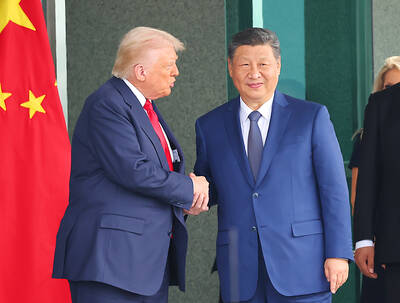High-speed data transmission chip designer ASMedia Technology Inc (祥碩) yesterday said revenue would grow sequentially next quarter, fueled by robust upgrade demand for USB 4.0 technology and increased demand for Advanced Micro Devices Inc’s (AMD) desktop chips and motherboards.
ASMedia said it expects to benefit from AMD’s share gains over Intel Corp in the desktop computer processor and motherboard market, as Intel is apparently facing challenges to introduce new processors such as the Arrow Lake central processing unit.
“That is prompting strong sales of AMD’s high-end X870 motherboard, as well as ASMedia’s revenue. We expect AMD to maintain the strong growth momentum through the first half of next year,” ASMedia president Lin Che-wei (林哲偉) told reporters following the company’s annual shareholders’ meeting in Taipei.

Photo: Lisa Wang, Taipei Times
“ASMedia is growing together with the customer as it keeps winning market share,” Lin said.
Strong demand led to supply constraints in the initial stages, but the issue has been resolved, he said.
ASMedia helps design motherboard chipsets for AMD desktop platforms, with the Taiwanese company responsible for the input and output functionality and features that connect the central processing unit to the motherboard and other devices.
ASMedia is in talks with a second customer about designing motherboard chipsets, Lin said.
As AMD’s X870 motherboard gains traction, it also helps boost demand for ASMedia’s USB 4.0 chips as such high-speed data transmission technology comes standard with the motherboard, he said.
ASMedia expects the chipset designing business for AMD and its own-brand USB 4.0 chips to continue driving the company’s revenue growth through next quarter.
“The visibility for the third quarter is clear. It will be a better than the second quarter, even without including revenue from newly acquired Techpoint Inc,” Lin said.
With the participation of Techpoint, ASMedia expects its own-brand chip revenue to rise gradually to make up half of the company’s total revenue, with revenue from the AMD motherboard chipset designing business accounting for the other half, he said.
Overall, revenue this year would exceed last year’s NT$8.08 billion (US$272.3 million), Lin said.
ASMedia earlier this year projected that revenue would expand at a double-digit percentage compared with last year.
Gross margin would be the company’s target range of 50 to 55 percent, after factoring in the impact of the appreciation of the New Taiwan dollar, Lin said.
Every 1 percent appreciation in the NT dollar against the US dollar would reduce the company’s gross margin by 0.1 to 0.2 percentage points, he said.
ASMedia expects the foreign exchange rate risk to minimize next quarter as its US dollar cash position dwindles.
The company has spent all US$330 million it raised through issuing global depository receipts last year on acquiring Techpoint, Lin said.
ASMedia shareholders yesterday approved a cash dividend of NT$30 per common share, the highest in the company’s history. That represented a payout ratio of 58.17 percent based on the company’s earnings per share of NT$51.57 last year.

RUN IT BACK: A succesful first project working with hyperscalers to design chips encouraged MediaTek to start a second project, aiming to hit stride in 2028 MediaTek Inc (聯發科), the world’s biggest smartphone chip supplier, yesterday said it is engaging a second hyperscaler to help design artificial intelligence (AI) accelerators used in data centers following a similar project expected to generate revenue streams soon. The first AI accelerator project is to bring in US$1 billion revenue next year and several billion US dollars more in 2027, MediaTek chief executive officer Rick Tsai (蔡力行) told a virtual investor conference yesterday. The second AI accelerator project is expected to contribute to revenue beginning in 2028, Tsai said. MediaTek yesterday raised its revenue forecast for the global AI accelerator used

TEMPORARY TRUCE: China has made concessions to ease rare earth trade controls, among others, while Washington holds fire on a 100% tariff on all Chinese goods China is effectively suspending implementation of additional export controls on rare earth metals and terminating investigations targeting US companies in the semiconductor supply chain, the White House announced. The White House on Saturday issued a fact sheet outlining some details of the trade pact agreed to earlier in the week by US President Donald Trump and Chinese President Xi Jinping (習近平) that aimed to ease tensions between the world’s two largest economies. Under the deal, China is to issue general licenses valid for exports of rare earths, gallium, germanium, antimony and graphite “for the benefit of US end users and their suppliers

Dutch chipmaker Nexperia BV’s China unit yesterday said that it had established sufficient inventories of finished goods and works-in-progress, and that its supply chain remained secure and stable after its parent halted wafer supplies. The Dutch company suspended supplies of wafers to its Chinese assembly plant a week ago, calling it “a direct consequence of the local management’s recent failure to comply with the agreed contractual payment terms,” Reuters reported on Friday last week. Its China unit called Nexperia’s suspension “unilateral” and “extremely irresponsible,” adding that the Dutch parent’s claim about contractual payment was “misleading and highly deceptive,” according to a statement

The Chinese government has issued guidance requiring new data center projects that have received any state funds to only use domestically made artificial intelligence (AI) chips, two sources familiar with the matter told Reuters. In recent weeks, Chinese regulatory authorities have ordered such data centers that are less than 30 percent complete to remove all installed foreign chips, or cancel plans to purchase them, while projects in a more advanced stage would be decided on a case-by-case basis, the sources said. The move could represent one of China’s most aggressive steps yet to eliminate foreign technology from its critical infrastructure amid a